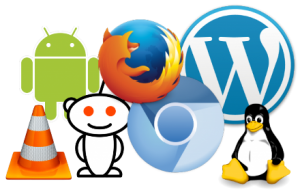Open-Source Software
Software Column
by Allen McLean, RN, MN, MSc, PhD(c)
Allen is currently a PhD student in Computer Science at the University of Saskatchewan in the Computational Epidemiology and Public Health Informatics Lab. His research interests include the development of computer modeling and simulation software for addressing health systems challenges, chronic diseases and health inequities at the population level, as well as machine learning techniques applied to large health datasets. Allen previously attended the University of Victoria earning an MN and MSc (Health Information Science) in a unique dual degree program for Nursing Informatics professionals. Allen has over 20 years’ experience in healthcare as an ultrasound technologist, clinical educator, team leader and community health RN.
COLUMN
 Many of us have likely heard the terms ‘Open-Source’ software or ‘Free’ software. The terms are often used interchangeably or in combination, but there are important differences. Open-source software is software whose source code is available for modification or enhancement by anyone. The ‘source code’ is the part of a software program that most computer users don’t ever see; it’s the code computer programmers can manipulate to change how a piece of software – a ‘program’ or ‘application’ – works. Programmers who have access to a computer programs source code can improve that program by adding features to it, or fixing parts that don’t always work correctly. An open source licence allows for anyone to legally access, modify and re-distribute that software. Examples include Firefox, WordPress, OpenOffice and Google Chrome. Interestingly, many commercial software products were originally open-source projects.
Many of us have likely heard the terms ‘Open-Source’ software or ‘Free’ software. The terms are often used interchangeably or in combination, but there are important differences. Open-source software is software whose source code is available for modification or enhancement by anyone. The ‘source code’ is the part of a software program that most computer users don’t ever see; it’s the code computer programmers can manipulate to change how a piece of software – a ‘program’ or ‘application’ – works. Programmers who have access to a computer programs source code can improve that program by adding features to it, or fixing parts that don’t always work correctly. An open source licence allows for anyone to legally access, modify and re-distribute that software. Examples include Firefox, WordPress, OpenOffice and Google Chrome. Interestingly, many commercial software products were originally open-source projects.
Free software is exactly as the term implies, free of charge; but that does not necessarily mean the user has a licence to access, change or distribute that software. Some software has source code that cannot be modified by anyone but the person, team, or organization who created it, and maintains exclusive control over it. This kind of software is frequently called ‘proprietary software’ or ‘closed source’ software, because its source code is the property of its original authors, the only ones legally allowed to copy or modify it. Microsoft Office is an example.
Benefits of open-source software include increased security; ‘Linus’ Law,’ named for Linus Torvalds, the creator of Linux. According to that maxim, “Given enough eyeballs, all bugs are shallow.” Meaning that, the more people who can see and test a set of code, the more likely any flaws will be caught and fixed quickly. Open-source software is also generally of higher quality; just as there are countless developers and users working to improve the security of open source software, so are there just as many innovating new features and enhancements to those products. Open-source software is highly customizable, free of restrictive proprietary licencing requirements, often excellent interoperability, greatly reduced costs and a ‘try before you buy’ option to determine if the software meets your needs.
Why is this topic of importance to nurses? Many reasons!
Nurses with an interest in programming might choose to use their clinical expertise to develop a fantastic new Android or iPhone app based on an existing piece of software. For those without a coding background, maybe technical documentation is an option. Because open-source projects are typically under-resourced, there will always be a need for our talents. Maybe you have always wanted to volunteer your time and skills but have never found opportunities as a Nurse Informatics professional, but you really do have opportunities! Healthcare software is often very expensive, and not all facilities have the resources to acquire a commercial EHR product. Open-source software development is done by volunteers, often simply for the personal satisfaction of creating an innovative and useful product. The folks working on projects such as OpenEMR [1] are bringing the benefits of electronic health records to peoples and facilities with limited financial resources. Nurses can contribute greatly to projects such as this. Our clinical backgrounds are highly valued by the software engineers on these teams…but don’t just take my word for it, ask around, I am sure you will be eagerly welcomed with open arms.
[1] OpenEMR. (2015) Retrieved from http://www.open-emr.org/






